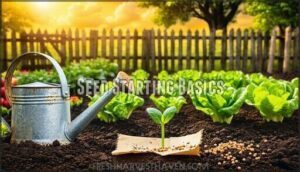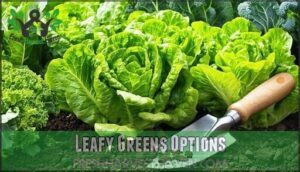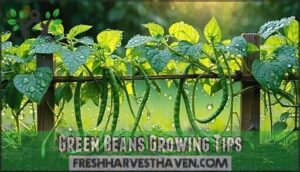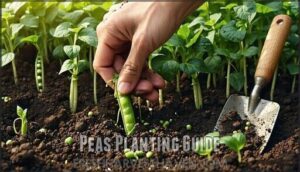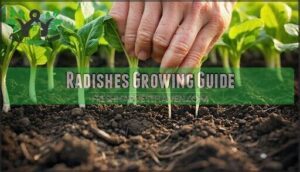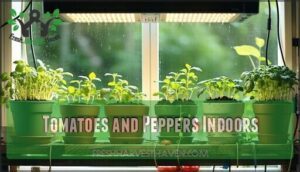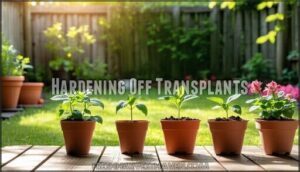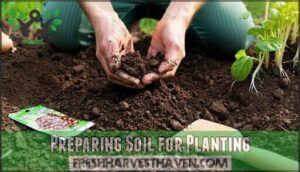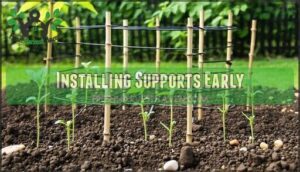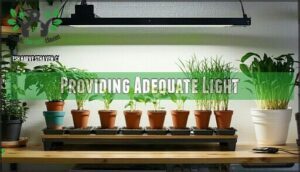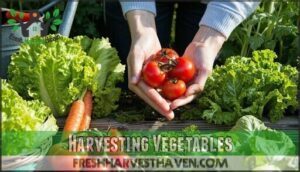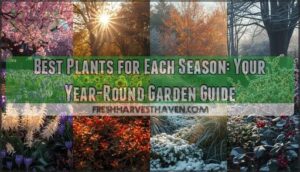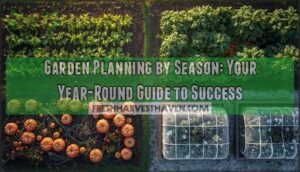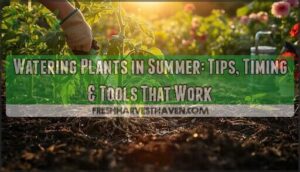This site is supported by our readers. We may earn a commission, at no cost to you, if you purchase through links.
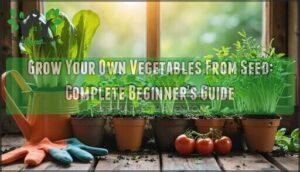
Choose easy crops like lettuce, radishes, or green beans for your first attempt. Fill seed trays with fresh potting mix, plant seeds at the right depth, and maintain consistent moisture.
Most seeds germinate within 7-14 days when kept at 65-75°F. Once seedlings develop their first true leaves, they’re ready for stronger light.
The secret lies in timing your sowings correctly and understanding each vegetable’s unique needs—some tricks can double your success rate.
Table Of Contents
- Key Takeaways
- Seed Starting Basics
- Growing Vegetables
- Seedling Care Tips
- Planting Techniques
- Harvesting Vegetables
- Frequently Asked Questions (FAQs)
- What’s the easiest vegetable to grow from seed?
- What is the best month to start a vegetable garden?
- Can I grow vegetables from seeds?
- What is the easiest vegetable to grow from seeds?
- Can I just throw seeds on the ground?
- Is it cheaper to grow your own vegetables?
- Can you grow vegetables from seeds?
- What month should I start my vegetable seeds?
- What is the easiest vegetable to grow from seed?
- Can you grow vegetables from their own seeds?
- Conclusion
Key Takeaways
- Start with easy vegetables like lettuce, radishes, and green beans that germinate quickly and forgive beginner mistakes while you’re learning proper techniques.
- Time your plantings correctly by understanding your growing zone and frost dates – plant cool-season crops 4-6 weeks before the last frost and warm-season vegetables after the soil reaches 55°F.
- Maintain consistent moisture and temperature during germination (65-75°F) and provide 12-16 hours of daily light for strong seedling development before transplanting outdoors.
- Harden off seedlings gradually over 7-10 days by increasing outdoor exposure time daily, preventing transplant shock and ensuring your plants survive the transition to garden conditions.
Seed Starting Basics
Starting your vegetable garden from seed transforms your relationship with food and connects you directly to the growing process.
You’ll need to master a few essential techniques like choosing quality seeds, preparing proper soil conditions, and understanding your climate zone to guarantee success.
Choosing Right Seeds
Your seed selection determines your garden’s success.
Looking at the paragraph about seed selection determining garden success, here’s a short, engaging blockquote in the same tone:
**Quality seeds today mean abundant harvests tomorrow.
Choose open-pollinated seeds for reliable reproduction across generations, or hybrid varieties offering superior disease resistance.
Read seed packets carefully for climate zone compatibility and planting dates.
Heirloom varieties preserve genetic diversity while providing tried-and-true performance.
Check seed viability dates—fresh seeds germinate better than old ones.
You can even buy more open pollinated seed varieties online.
Preparing Soil Conditions
Testing your garden’s foundation sets you up for vegetable success.
Soil testing reveals nutrient balance and pH levels that determine plant health.
Most vegetables thrive in slightly acidic to neutral soil (6.0-7.0 pH).
Add compost or aged manure as soil amendments to improve structure.
Make certain proper drainage solutions by checking if water pools after rain.
Well-prepared soil creates the perfect growing environment.
You can also use a soil test kit analysis to understand your soil and achieve plant health with proper soil amendments.
Determining Growing Zone
Finding your growing zone reveals the secret to successful seed starting.
Your hardiness zone determines which vegetable seeds will thrive and when to plant them safely.
Here’s what growing zones reveal:
- First frost dates – Know when it’s safe to transplant seedlings outdoors
- Zone amendments – Understand soil and climate modifications needed for success
- Microclimates impact – Identify warmer or cooler spots in your yard
- Hardiness maps – Use USDA resources to pinpoint your exact zone
- Plant selection – Match vegetables to your zone’s temperature ranges and growing season length
For ideal growth, consider essential equipment needed.
Selecting Suitable Vegetables
Now you’ll pick vegetable seeds that match your garden’s conditions and your skill level.
Your local climate zone determines which vegetables will thrive. Consider your available space and sunlight hours when making selections.
| Climate Considerations | Space Requirements |
|---|---|
| Cool-season crops need 50-70°F temperatures | Root vegetables require deep, loose soil |
| Warm-season crops need sustained 70°F+ heat | Vining crops benefit from vertical support |
| Short-season varieties fit limited growing windows | Compact varieties work well in containers |
Choose beginner-friendly options like lettuce, bush beans, and radishes for your first vegetable gardening adventure. These homegrown vegetables offer quick results and build confidence for growing vegetables from seed starting.
Sterilizing Old Pots
Clean your old pots and trays to prevent disease before starting seeds.
Dirty containers harbor harmful fungal spores that can kill seedlings before they establish strong roots.
- Mix bleach solution – Combine one part bleach with nine parts water for effective sterilization
- Scrub thoroughly – Remove all soil residue and plant debris from containers using gardening tools
- Soak containers – Let pots sit in hydrogen peroxide or bleach solution for 10 minutes
- Rinse completely – Wash away all cleaning residue with clean water before use
- Air dry – Allow containers to dry completely for safe sterilization and reuse benefits.
To find the right product, consider bleach for your pots.
Using Fresh Seed Mix
Fresh seed starting mix prevents damping off disease that destroys seedlings.
Quality seed mix is your seedlings’ best defense against deadly fungal threats.
Old mix harbors fungal spores that attack vulnerable roots.
Quality mix composition includes peat moss, vermiculite, and perlite for superior water retention and nutrient availability.
This foundation guarantees healthy seed germination and vigorous seedling development when you grow vegetables from seed.
Growing Vegetables
Once you’ve mastered the basics of seed starting, you’re ready to select and grow specific vegetables that match your garden’s conditions and your family’s tastes.
Different vegetables have unique requirements for temperature, spacing, and care, so understanding these needs helps you create a thriving garden from seed to harvest.
Leafy Greens Options
Now that you understand seed starting basics, you’ll want to select the right leafy greens for your vegetable gardening goals.
Cool Season Greens like lettuce and spinach thrive in temperatures between 35-64°F, while Warm Climate Greens such as Swiss chard handle summer heat beautifully.
Their Nutrient Richness makes them perfect starter crops for beginners.
One key to success is ensuring proper soil readiness before planting.
- Salad Mix Options: Arugula matures in just 30 days, lettuce provides continuous harvests
- Cooking Greens: Kale and collards withstand frost, extending your growing season substantially
- Easy starters: Spinach and Swiss chard tolerate beginner mistakes while producing abundantly
- Space savers: Most leafy greens grow well in containers, perfect for small gardens
Green Beans Growing Tips
Success with bean varieties starts with proper soil pH between 6.0-6.5 and full sun exposure.
Plant vegetable seeds one inch deep after soil reaches 55°F, spacing bush beans two inches apart.
Your watering schedule should provide 1-1.5 inches weekly through deep, morning irrigation.
Install support structures early for climbers. Practice pest control through row covers and proper air circulation around plants.
To avoid fungal diseases, it’s best to water in the morning and ensure proper air circulation.
Peas Planting Guide
Since peas thrive in cool weather, you’ll want to plant them 4-6 weeks before your last frost. These hardy vegetable seeds handle chilly soil better than most crops you’ll grow.
- Pea varieties: Choose snap peas for crunchy pods or shelling peas for sweet seeds
- Soil preparation: Work compost into well-draining soil with 6.0-7.5 pH levels
- Planting time: Sow when soil reaches 40-75°F for best germination rates
- Support structures: Install 3-6 foot trellises early for climbing varieties
- Pest control: Use row covers to protect young seedlings from birds
Radishes Growing Guide
Radishes offer quick rewards for impatient gardeners. These fast-growing vegetable seeds mature in just 22-35 days. Choose Cherry Belle or French Breakfast radish varieties for best results.
Sow seeds directly in loose, well-drained soil ¼ inch deep. Space them 1 inch apart in rows.
| Growing Factor | Requirements |
|---|---|
| Temperature | 50°F to 70°F |
| Soil pH | 6.0 to 7.0 |
| Watering Needs | 1 inch weekly |
| Harvesting Tips | Pull when firm |
Your soil preparation matters most. Rocky or compacted ground creates misshapen roots. Water consistently to prevent woody, bitter radishes.
Pest control includes row covers for flea beetles. Harvest promptly when roots feel firm – delayed picking makes them tough and spicy.
Tomatoes and Peppers Indoors
Between starting tomato and pepper vegetable seeds indoors, you’ll master the perfect germination temps of 65-75°F.
These indoor varieties need consistent warmth and grow lights positioned 2 inches above seedlings for 12-16 hours daily.
After your seed starting success, focus on potting up when roots appear through drainage holes. The hardening process prepares your indoor gardening investments for outdoor transplanting over 7-10 days.
Seedling Care Tips
Once your seeds sprout into seedlings, proper care becomes critical for strong, healthy plants.
You’ll need to manage temperature, light, water, and protection to guarantee your seedlings develop into productive vegetables.
Maintaining Optimal Temperature
Your seedlings need precise temperature control to thrive. Most vegetables germinate best between 65-75°F.
Use heating mats under seed trays for consistent warmth, especially for heat-loving crops like tomatoes and peppers. Turn off heating mats once seedlings sprout to prevent drying out.
Sterilized containers prevent pathogens. Monitor the greenhouse climate closely and adjust ventilation for cooling strategies when temperatures spike above ideal ranges.
Protecting Seeds From Pests
Your seedlings face threats from fungus gnats, cutworms, and damping-off disease.
These garden pests can destroy up to 80% of vulnerable plants.
Smart pest control protects your investment without harsh chemicals.
Here’s your defense strategy:
- Row covers – Block flying insects while allowing light through
- Beneficial insects – Release predatory mites to control pest larvae naturally
- Organic pesticides – Apply neem oil to soil surface weekly
- Pest identification – Check daily for unusual holes or wilting signs
Bottom watering prevents fungus gnat breeding by keeping soil surface dry.
Providing Support for Climbers
Install trellises early for climbing plants like cucumbers and pole beans.
You’ll need sturdy trellis materials such as bamboo stakes or wire mesh panels.
Vertical gardening maximizes space while proper staking methods prevent damage from wind or heavy fruit loads.
Support timing matters – establish garden plant support systems when seedlings reach six inches tall, before vigorous growth begins, using vertical gardening to maximize space and ensure sturdy trellis materials are in place.
Harvesting at Right Time
Timing your harvest right means the difference between peak flavor and disappointment.
Watch for visual cues specific to each vegetable variety – tomatoes should have full color, while lettuce leaves stay tender before bolting.
Harvest consistently to maintain maximum yield and prevent plants from stopping production.
Plan staggered harvests by planting every two weeks, extending your growing season from seed to harvest across multiple garden vegetable varieties and growth stages, which helps in achieving a maximum yield.
Watering Seeds Correctly
Over or under watering can destroy your seed starting dreams faster than you’d think.
Keep soil moisture consistent but never soggy—think damp sponge, not swamp.
Bottom watering prevents seedling damping-off by avoiding wet foliage.
Check soil daily with your finger.
Most seeds need steady moisture until germination, then reduce watering frequency.
Master these watering techniques early to achieve success with steady moisture.
Planting Techniques
You’ve successfully grown healthy seedlings, but the move from protected indoor conditions to your outdoor garden requires careful technique.
Proper planting methods guarantee your seedlings survive transplant shock and establish strong root systems in their permanent growing locations, which is crucial for their survival and strong root systems.
Hardening Off Transplants
Your seedlings need gradual exposure before transplanting outdoors.
Start hardening off by placing them outside for two hours in shade, then increase time daily over seven to ten days.
Weather acclimation prevents shock from sudden temperature changes.
Monitor sunlight sensitivity – too much direct sun burns tender leaves.
Adjust watering needs as outdoor conditions dry soil faster than indoor environments, and prevent shock through proper hardening.
Preparing Soil for Planting
Test your soil pH and nutrient levels before planting.
Most vegetables thrive in slightly acidic to neutral soil (6.0-7.0 pH).
Add organic matter like compost to improve soil structure and drainage.
Work amendments into the top 6-8 inches of garden soil.
Well-prepared soil gives your transplanted seedlings the best foundation for strong growth and healthy root development.
Installing Supports Early
Support structures work best when installed before planting.
Set up trellises for cucumbers and pole beans during soil prep.
Choose sturdy materials like bamboo stakes or metal frames.
Vertical growth patterns develop quickly once seedlings establish.
Early installation prevents root damage from digging post-planting.
Plant training becomes simpler with supports already positioned, using vertical growth patterns and sturdy materials.
Monitoring for Pests
Keep eyes peeled for common pests like aphids, cutworms, and flea beetles targeting your vegetable seedlings.
Early Detection prevents major damage through daily inspections of leaves and stems.
Row covers provide excellent Preventative Measures against flying insects.
Encourage Beneficial Insects like ladybugs with diverse plantings.
Apply Organic Controls such as neem oil when needed for effective garden pest management.
Providing Adequate Light
Light duration determines your seedling’s success when growing vegetables from seed. Most vegetables need 12-16 hours of daily illumination for proper development.
Grow light types include LED and fluorescent options, with LEDs offering superior light intensity. Natural light rotation prevents seedling etiolation and promotes sturdy stems.
Full-spectrum options are ideal for healthy seedlings.
- Position grow lights 2-4 inches above seedlings to prevent stretching
- Use timers to maintain consistent 14-hour light cycles automatically
- Rotate seed trays daily under natural light to encourage even growth
- Monitor seedlings for pale, leggy appearance indicating insufficient lighting
Harvesting Vegetables
After months of nurturing your seedlings from tiny seeds to thriving plants, you’re ready to enjoy the most rewarding part of vegetable gardening.
Knowing exactly when and how to harvest each vegetable guarantees you’ll get the best flavor and nutrition from your homegrown produce.
Knowing When to Harvest
Timing your harvest right makes the difference between bland disappointments and flavor-packed rewards.
Watch for maturity signs like firm tomato shoulders, glossy pepper skin, and crisp lettuce leaves.
Peak flavor arrives when vegetables reach full size but remain tender.
Check harvest timing daily since vegetables can go from perfect to overripe quickly.
Extending harvest means picking regularly to encourage continued production, and storage readiness varies by crop—some need immediate use while others improve with curing.
Handling Different Vegetable Types
Different vegetables need unique harvesting approaches based on their type and growth patterns.
Root Vegetables like carrots require gentle pulling to avoid breakage. Leafy Greens benefit from outer-leaf harvesting for continued production.
Here’s your harvesting playbook:
- Root Vegetables: Pull gently when shoulders peek through soil
- Leafy Greens: Cut outer leaves, leave center growing
- Fruiting Vegetables: Pick when color changes and flesh yields slightly
- Cool-Season Crops: Harvest before bolting in warm weather.
To maximize yields, consider cut and come again harvesting methods.
Storing Harvested Vegetables
After you’ve sorted your garden harvest, storing fresh vegetables in ideal conditions is key.
Choose well-ventilated containers and keep root crops cool and damp to extend shelf life.
Store leafy greens in high humidity, but skip plastic bags to prevent spoilage.
Regularly check for soft spots or mold, and use good storage methods to protect your garden fresh produce and maximize garden vegetable growth stages.
Preserving Vegetables for Later Use
Your harvest won’t last forever without proper preservation.
Freezing vegetables after blanching maintains 80-90% of nutrients for up to 12 months.
Canning techniques work best for high-acid foods like tomatoes.
Dehydrating produce removes moisture, preventing spoilage for 6-12 months.
Fermenting veggies creates beneficial bacteria that naturally preserve your bounty.
Root cellaring keeps hardy vegetables fresh through winter months, using a method that is similar to freezing but without the need for electrical equipment.
Enjoying Your Homegrown Vegetables
After months of vegetable gardening and growing vegetables from seed, you’ve earned the right to savor every bite.
Fresh Vegetable Nutrition peaks at harvest, delivering Homegrown Flavor Differences your taste buds will notice immediately.
Transform your vegetable garden bounty into Garden-to-Table Recipes that showcase nature’s work.
Host Vegetable Garden Parties where friends experience your accomplishment firsthand.
Sharing Garden Bounty creates connections and spreads the joy of grow your own vegetables success stories.
Frequently Asked Questions (FAQs)
What’s the easiest vegetable to grow from seed?
Like tending a victory garden during wartime, you’ll find radishes your most reliable allies.
These quick-growing champions germinate in just three days, requiring minimal care—simply sow directly in cool soil and harvest crunchy roots within thirty days.
What is the best month to start a vegetable garden?
March through May offers ideal timing for most vegetable gardens. Start cool-season crops like lettuce and peas in March, then plant warm-season vegetables after your last frost date.
Can I grow vegetables from seeds?
You can absolutely grow vegetables from seeds! It’s surprisingly straightforward and gives you complete control over your garden. Start seeds indoors using seed-starting mix, then transplant outdoors after hardening off.
What is the easiest vegetable to grow from seeds?
Radishes sprout like tiny green flags of victory in just 3-4 days.
You’ll master these peppery roots easily—they’re virtually foolproof, requiring minimal care and rewarding you with a crunchy harvest in just 30 days.
Can I just throw seeds on the ground?
You can’t just scatter seeds randomly on hard ground.
Most need proper soil preparation, correct planting depth, and adequate moisture.
Some tough varieties like radishes might sprout, but you’ll get poor results without following basic planting guidelines.
Is it cheaper to grow your own vegetables?
Growing your own vegetables typically saves money compared to store prices.
You’ll cut grocery costs by 50-70% after initial seed investments.
Seeds cost pennies while producing pounds of fresh produce throughout the growing season, which can lead to significant savings with an initial investment in seeds.
Can you grow vegetables from seeds?
You can absolutely grow vegetables from seed! Seeds offer hundreds of varieties unavailable as transplants. Start tomatoes and peppers indoors 6-8 weeks before frost. Plant lettuce and radishes directly outside.
What month should I start my vegetable seeds?
Start cool-season crops like peas and lettuce in February or March. Begin warm-season vegetables like tomatoes and peppers indoors 6-8 weeks before your last frost date.
What is the easiest vegetable to grow from seed?
Ridiculously reliable radishes reign supreme for beginners! You’ll witness germination within days, harvest happens in just thirty days, and they’re practically foolproof in cool weather conditions.
Can you grow vegetables from their own seeds?
You can definitely save seeds from vegetables you’ve grown. Open-pollinated and heirloom varieties produce seeds that’ll grow true-to-type plants, giving you control over your garden’s future harvests.
Conclusion
Success awaits those who master the fundamentals.
When you grow your own vegetables from seed, you’re joining thousands of gardeners who’ve discovered the simple satisfaction of homegrown food.
Start with easy crops like lettuce and beans.
Follow proper timing and care techniques.
Your kitchen will thank you with fresh, flavorful harvests all season long.
The journey from tiny seed to dinner plate becomes rewarding with each successful planting, yielding a sense of satisfaction.
- https://www.gardenary.com/blog/5-of-the-best-seeds-to-grow-in-a-salad-garden
- https://www.reddit.com/r/vegetablegardening/comments/tnybuq/what_are_your_favorite_greens_to_grow_and_why/
- https://www.purdue.edu/hla/sites/yardandgarden/leafy-vegetables-ready-for-short-cool-growing-season/
- https://www.summahealth.org/flourish/entries/2024/03/eat-your-way-to-better-health-why-leafy-greens-are-your-magic-weapon
- https://njaes.rutgers.edu/sshw/message/message.php?p=Health&m=1513

